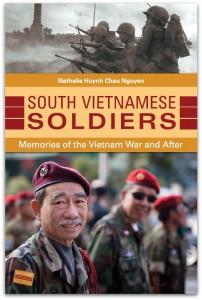From the bookshelf: the defeated South Vietnamese army
Posted By Peter Edwards on August 18, 2016 @ 14:30
 [1]Historians still argue about the winners and losers of the Vietnam War, but there were two undoubted losers: the Republic of Vietnam—commonly known as South Vietnam—and its army, generally known as ARVN. The soldiers of ARVN not only suffered defeat on the battlefield, but they were also treated extremely harshly by the victorious Vietnamese communists, received little respect from their allies, and have largely been written out of historical accounts of the war.
[1]Historians still argue about the winners and losers of the Vietnam War, but there were two undoubted losers: the Republic of Vietnam—commonly known as South Vietnam—and its army, generally known as ARVN. The soldiers of ARVN not only suffered defeat on the battlefield, but they were also treated extremely harshly by the victorious Vietnamese communists, received little respect from their allies, and have largely been written out of historical accounts of the war.
South Vietnamese Soldiers [2], by Monash University academic Nathalie Huynh Chau Nguyen, is therefore an unusual and welcome addition to the burgeoning literature on the war. Dr. Nguyen’s father was the last RVN Ambassador to Japan: he and his family were among the few South Vietnamese who were given refuge in Australia immediately after the fall of Saigon on 30 April 1975. Much of this book is based on interviews with the South Vietnamese veterans, men and women who arrived later, often as boat people.
After the war ARVN soldiers, especially officers, were subjected by the victorious communists to even harsher penalties than civilians, including years of forced labor and indoctrination in ‘re-education camps’. Thousands died from sickness and starvation; those who survived and didn’t manage to escape to the west were treated with contempt and discrimination, which were even extended to their children and grandchildren. The main South Vietnamese military cemetery at Bien Hoa was vandalised and virtually abandoned until recent years. Even in death the soldiers were treated as puppets, not people.
Moreover, before, during and after the war the American military and the media frequently conveyed an impression of an incompetent and unmotivated army serving a corrupt regime. The regime and its army were, it was widely alleged, reluctant to fight and to take casualties, being determined only ‘to fight to the last American’. Those allegations did much to undermine support for South Vietnam in one of the war’s most crucial battlegrounds, American public opinion.
Nathalie Nguyen’s book serves as an important corrective to many of the familiar and damaging allegations. ARVN did fight, and did take casualties. We may never know the exact numbers, but around quarter of a million service personnel died and about three times that number were wounded. Compare that with the 58,000 American forces, and just over 500 Australian service personnel, officially regarded as killed in action. It’s simply not true that the South Vietnamese were shirking the battle. In the last years of the war, after the Americans and their allies had withdrawn, the South Vietnamese forces lost more casualties in a year than the Americans had for the entire war.
The South Vietnamese soldiers display pride in military achievement, such as the performance of some units when the South repulsed the North’s unsuccessful offensive in 1972. Much was said in the west about ARVN officers appointed for their political connections rather than military skill but this book reveals loyalty and pride in their brothers-in-arms (and sisters-in-arms) and in officers who commanded respect. There are no allegations of a ‘stab in the back’ by Saigon politicians. The only recrimination is directed against the US Congress, which cut off supplies to the South in 1974.
Much of the political and military drive in South Vietnam came from the million who came into the South from provinces north of the 17th parallel after the partition in 1954. Much has always been made of the fact that many of them, including Ngo Dinh Diem, were Catholics. But Nguyen shows that many of those who came south were Buddhists and other non-Catholics, equally motivated to fight the communists. They had experienced communist rule in the north, and they brought some of the north’s military skill and political motivation to the anti-communist cause.
Like the Vietnamese National Army under the French, ARVN was created along a western model. It was designed to rely on the sort of firepower, logistics and transport that the American forces used, but it wasn’t supplied with the same quality or quantity of logistic support. A recurring theme in these interviews is the frustration of the South Vietnamese forces when the US Congress cut support in 1974, while the north continued to receive massive support from the Soviet Union and China. The South Vietnamese forces had arms but no ammunition, equipment but no spare parts. When ARVN soldiers were reduced to three rounds per day, defeat was inevitable.
Like any army, ARVN units were generally as good as their officers and their training. Just as the first Anzacs were far more effective soldiers by 1918 than they had been in 1915, so too the South Vietnamese Army was more effective in the early 1970s than it had been in the early 1960s.
The South Vietnamese soldiers in this book, and the hundreds of thousands whom they represent, were people not puppets, who fought for a country and a set of ideals in which they believed, as much as any army believes in its own cause. They were defeated, but deserve not to be denigrated by both their conquerors and their allies. As we approach the 50th anniversary of the Battle of Long Tan, Australians would do well to give a thought to their South Vietnamese allies.
Article printed from The Strategist: https://aspistrategist.ru
URL to article: /bookshelf-defeated-south-vietnamese-army/
URLs in this post:
[1] Image: https://aspistrategist.ru/wp-content/uploads/2016/08/NathalieNguyen_SouthVietnameseSoldiers-e1471478869151.jpg
[2] South Vietnamese Soldiers: https://www.amazon.com/South-Vietnamese-Soldiers-Memories-Vietnam/dp/1440832412
Click here to print.